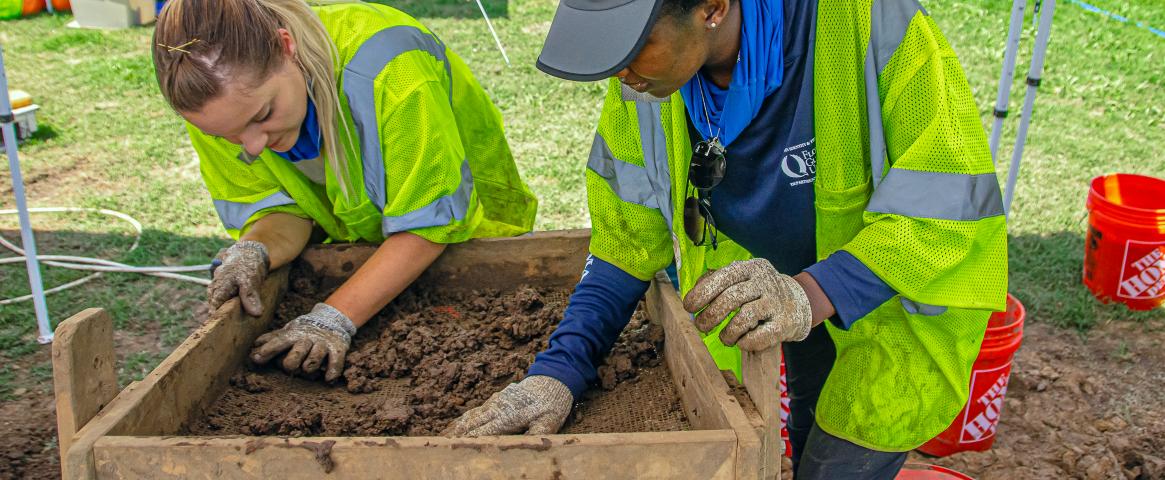By Julia Cooper. Mentored and edited by Heather Goss.
From the search for the ‘Original 18’ of the Tulsa Race Massacre to the identification of Ugandans killed during a protracted civil war, scientists are piecing together the past by identifying remains using ethnographic and forensic data collection.
During a Feb. 19 presentation at the American Association for the Advancement of Science annual meeting, experts in forensic and cultural anthropology discussed their work investigating unmarked burial sites. This niche of anthropology attempts to recover information about those who have died without proper burial documentation, who researchers sometimes call the ‘difficult dead.’
Phoebe R. Stubblefield, interim director of the C. A. Pound Human Identification Lab at the University of Florida, presented her methodology on a forensic analysis of skeletal material that was collected during archaeological surveys of an unmarked area of Oaklawn cemetery in Tulsa, Okla. During the summer of 2021, her team attempted to locate and identify the 18 Black people, only 13 of whom are named, included on a funeral home ledger billed to the city in the wake of the 1921 Tulsa Race Massacre.
Stubblefield’s team exhumed, hand-cleaned, and collected data, including x-rays, of remains from 19 bodies. They are creating a database of physical characteristics like height, age, sex, and other identifying features, like dental implants.
The work is both physically and ethically challenging. “How do we look for the hidden while at the same time respecting those who were intentionally buried,” Stubblefield said. They worked onsite in a trailer converted into a laboratory as a “show of intent and respect for those who were intentionally buried even if their graves became unmarked.” Keeping the remains nearby also allowed the team to more easily return them to their original resting spots.
Methods like this represent a humanistic approach in forensics, said Sean Tallman, an assistant professor for the Department of Anthropology at Boston University who was not involved with the research. “With these sorts of humanitarian investigations, whether it’s just preliminary work or whether you’re actually excavating, I think it’s really important to be in contact with and working closely with the affected communities,” he said.
Tallman said he has seen practices like Stubblefield’s as part of several trends in the field of forensic anthropology for both the scientists themselves and the communities they study. These practices support diversity and inclusion in the field, put a focus on mental health care for scientists, and ask researchers to consider their own biases and how it may shape their findings.
Stubblefield views her work as contributing scientific evidence to back up historical narratives in an era where many struggle with discerning fact from fiction. She also sees this as an opportunity to bring some peace to people who have long sought evidence of this event to support personal accounts.
“We may look at it like ‘only the truth is important,’” she said. “Truth is important, but so is peace.”
Tricia Redeker-Hepner, who presented on the panel with Stubblefield, is a cultural anthropologist and director of the Master's Program in Social Justice and Human Rights at Arizona State University. She travels to Uganda to better understand the implications of improper burials and mass graves on communities.
With a team of forensic scientists and local collaborators, Redeker-Hepner spent several years performing more than 170 interviews with locals of the Northern Acholi region of Uganda, an area marked by a decades-long war between the Lord’s Resistance Army (LRA) and the Ugandan Government. The information led them to a dozen potential burial sites, which they mapped with photographs, satellite imagery and on the ground measurements.
In Uganda, her interviews revealed that these improper burials are causing “culturally specific manifestations of trauma” for people through perceived spiritual disturbances and nightmares about the dead. One unexpected finding was that these sites are also having a negative economic impact on people who rely on subsistence farming.
“The graves are in the way,” she said. “If you have a field that is riddled with graves and you don’t know who those people are you can’t farm or build on that field because if you disturb those bones it’s horrifying…[and] inviting spiritual disturbances.”
Asking tough questions helps keep researchers from falling prey to what Redeker-Hepner called “forensic fetishism,” where scientists excavate mass graves without considering if that might re-traumatize a group of people.
“The question is not where to dig and when to dig, but whether to dig,” she said. “As Western scientists we might find it fascinating to go and do this work. Well, that’s not a good enough reason to do it. That’s not any reason to do it.”
Julia Cooper is a third-year student at the University of Florida, with a major in journalism and a minor in women’s studies. She has reported for the Independent Florida Alligator and the Gainesville Sun. She is a producer for WUFT News’ The Point Podcast and reporter for Fresh Take Florida. Find her on Twitter @JuliaArinCooper.
Photo: Members of the 1921 Graves Investigation team conduct research at Oaklawn Cemetery in Tulsa, Oklahoma in June 2021 to identify remains of the Tulsa Race Massacre victims known as the “Original 18.” Credit: City of Tulsa.

